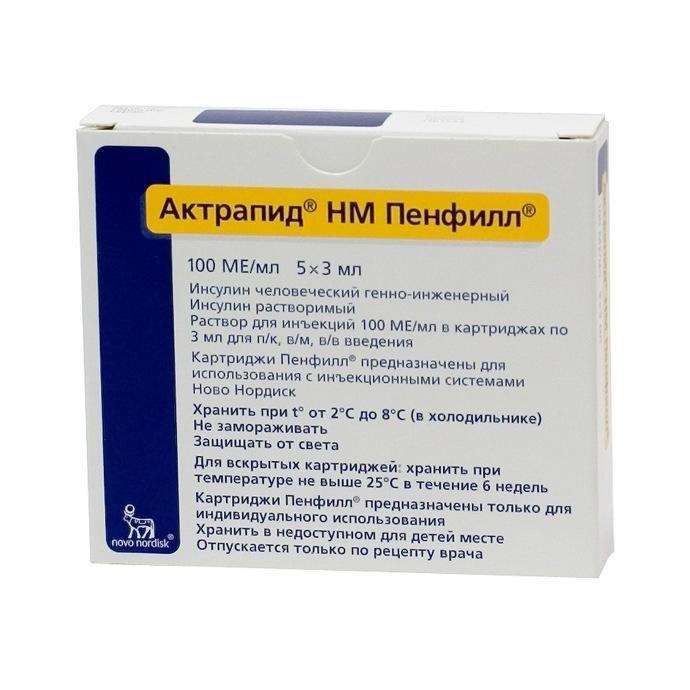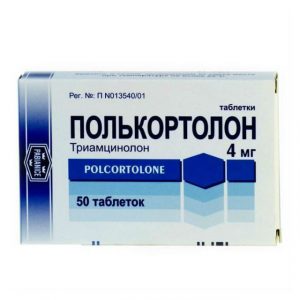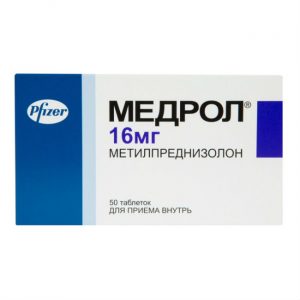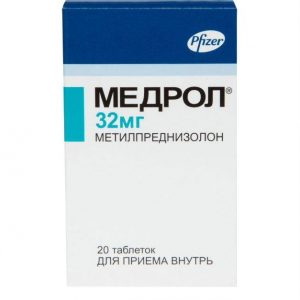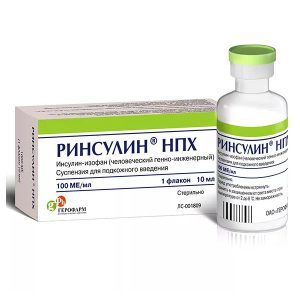Description
Latin name
ACTRAPID HM PENFILE
Release form
Injection.
Packing
5 ampoules of 3 ml.
Pharmacological action
Actrapid ® NM is a short-acting insulin preparation produced by recombinant DNA biotechnology using the Saccharomyces cerevisiae strain.
Interacts with a specific receptor on the outer cytoplasmic membrane of cells and forms an insulin-receptor complex. Through the activation of cAMP biosynthesis (in fat cells and liver cells) or, directly penetrating into the cell (muscles), the insulin-receptor complex stimulates intracellular processes, including synthesis of a number of key enzymes (hexokinase, pyruvate kinase, glycogen synthetase, etc.).
The decrease in glucose in the blood is due to an increase in its intracellular transport, increased absorption and assimilation of tissues, stimulation of lipogenesis, glycogenogenesis, protein synthesis, a decrease in the rate of glucose production by the liver, etc.
The duration of action of insulin preparations is mainly due to the absorption rate, which depends on several factors (for example, dose, method, place of administration and type of diabetes). Therefore, the profile of insulin action is subject to significant fluctuations, both in different people and in the same person.
The action of the drug Actrapid NM begins within half an hour after administration, and the maximum effect is manifested within 1.5-3.5 hours, while the total duration of action is about 7-8 hours.
Indications
Insulin-dependent diabetes mellitus (type 1).
Non-insulin-dependent diabetes mellitus (type 2): stage of resistance to oral hypoglycemic agents, partial resistance to these drugs (during combination therapy), with intercurrent diseases, operations, during pregnancy.
Contraindications
Hypoglycemia.
Hypersensitivity to human insulin or to any component that is part of this drug.
Use during pregnancy and lactation
There are no restrictions on the use of insulin during pregnancy because insulin does not cross the placental barrier. Moreover, if you do not treat diabetes during pregnancy, this creates a danger to the fetus. Therefore, diabetes therapy must be continued during pregnancy.
Both hypoglycemia and hyperglycemia, which can develop in cases of inadequately selected therapy, increase the risk of fetal malformations and fetal death. Pregnant women with diabetes should be monitored throughout their pregnancy, and they need to have enhanced blood glucose control. The same recommendations apply to women who are planning a pregnancy. The need for insulin usually decreases in the first trimester of pregnancy and gradually increases in the second and third trimesters. After childbirth, the need for insulin quickly returns to the level that was noted before pregnancy.
There is also no restriction on the use of Actrapid HM during breastfeeding. Conducting insulin therapy for nursing mothers is not dangerous for the baby. However, the mother may need to adjust the dosage regimen of the drug Actrapid NM and / or diet.
Composition of
1 ml of solution contains:
Active ingredient: soluble insulin (human genetic engineering) 100 IU (3.5 mg), (1 IU corresponds to 0.035 mg of anhydrous human insulin).
Excipients: zinc chloride, glycerin (glycerol), metacresol, hydrochloric acid and / or sodium hydroxide (to adjust the pH level), water for injection.
Dosage and administration of
Actrapid HM Penfill solution d / in. 100 IU / ml cart.d / penfil. 3 ml pack 5 NovoNordisk A / O is used with: NovoPen Syringe Pen 3 Novo Nordisk A / O.
Syringe-pen NovoPen 3 Demi NovoNordisk A / O.
Syringe-pen NovoPen 4 pack. 1 Novo Nordisk A / O.
The drug is intended for subcutaneous and intravenous administration.
The dose of the drug is selected individually, taking into account the needs of the patient. Typically, insulin requirements are between 0.3 and 1 IU / kg / day. The daily requirement for insulin may be higher in patients with insulin resistance (for example, during puberty, as well as in patients with obesity), and lower in patients with residual endogenous insulin production.
If patients with diabetes achieve optimal glycemic control, then diabetes complications usually occur later. In this regard, one should strive to optimize metabolic control, in particular, by carefully monitoring the level of glucose in the blood.
Actrapid NM is a short-acting insulin and can be used in combination with prolonged-acting insulins.
The drug is administered 30 minutes before a meal or snack containing carbohydrates.
Actrapid NM is usually administered subcutaneously in the region of the anterior abdominal wall. If this is convenient, then injections can also be done in the thigh, gluteal region or in the region of the deltoid muscle of the shoulder. With the introduction of the drug into the region of the anterior abdominal wall, faster absorption is achieved than with the introduction to other areas. Performing an injection into the skin fold reduces the risk of getting into the muscle. It is necessary to change the injection site within the anatomical region in order to prevent the development of lipodystrophy. Intramuscular injections are also possible, but only as directed by a doctor. Actrapid NM is also possible to be administered intravenously and such procedures can only be performed by a medical professional.
Dose adjustment
With damage to the kidneys or liver, the need for insulin is reduced.
Side effects
Side effects, observed in patients during therapy with Actrapid NM, were mainly dose-dependent and were due to the pharmacological action of insulin. As with other insulin preparations, the most common side effect is hypoglycemia. It develops in cases where the dose of insulin significantly exceeds the need for it.
During clinical trials, as well as during the use of the drug after its release on the consumer market, it was found that the frequency of hypoglycemia is different in different patient populations and when using different dosage regimens, so it is not possible to indicate the exact frequency values. In severe hypoglycemia, loss of consciousness and / or convulsions may occur, temporary or permanent impairment of brain function, and even death, may occur. Clinical studies have shown that the incidence of hypoglycemia generally did not differ between patients receiving human insulin and patients receiving insulin aspart.
The following are the values of the frequency of adverse reactions detected during clinical trials, which were regarded as associated with the use of the drug Actrapid NM.
The incidence of these adverse events was estimated as follows: infrequently (> 1/1000, <1/100) very rarely (<1/10000), including isolated spontaneous cases. On the part of the immune system: infrequently – urticaria, rash very rarely – anaphylactic reactions. Symptoms of generalized hypersensitivity may include generalized skin rash, itching, sweating, disorders of the gastrointestinal tract, angioedema, shortness of breath, palpitations, decreased blood pressure, fainting / unconsciousness. Generalized hypersensitivity reactions can be life threatening. From the nervous system: very rarely – peripheral neuropathy. If the improvement in blood glucose control was achieved very quickly, a condition called acute painful neuropathy may develop that is usually reversible. From the side of the organs of vision: infrequently – refractive errors. Disturbances of refraction are usually noted at the initial stage of insulin therapy. As a rule, these symptoms are very rarely reversible – diabetic retinopathy. If adequate glycemic control is provided for a long time, the risk of progression of diabetic retinopathy is reduced. However, the intensification of insulin therapy with a sharp improvement in glycemic control can lead to a temporary increase in the severity of diabetic retinopathy. From the skin and subcutaneous tissues: infrequently – lipodystrophy. Lipodystrophy can develop at the injection site in the case when they do not constantly change the injection site within the same area of the body. On the part of the body as a whole, as well as reactions at the injection site: infrequently, reactions at the injection site. Against the background of insulin therapy, reactions may occur at the injection site (redness of the skin, swelling, itching, soreness, hematoma formation at the injection site). However, in most cases, these reactions are transient in nature and in the process of continuing therapy disappear infrequently – swelling. Swelling is usually noted at the initial stage of insulin therapy. As a rule, this symptom is transient in nature. Drug Interaction There are a number of medicines that affect your insulin requirement. The hypoglycemic action of insulin is enhanced, Preparations oral hypohlykemycheskye, ynhybytor oxidase, ynhybytor angiotensin-converting enzyme ynhybytor karboanhydraz , neselektyvn e 6eta-blockers, bromocriptine, sulfonamides, anabolic steroyd , tetratsyklyn , klofybrat, ketoconazole, mebendazole, pyridoxine, theophylline, tsiklofosfamida, fenfluramyn, Preparations cast Preparations soderzhaschye ethanol. Hypoglycemic action of insulin is attenuated by oral contraceptives, glucocorticosteroids, thyroid hormones, thiazide diuretics, heparin, tricyclic antidepressants-sympathomimetics, danazol, clonidine, blockers of canfinalis, canzalenes, cancals, canzalen Under the influence of reserpine and salicylates, both attenuation and intensification of the drug are possible. Beta-blockers can mask the symptoms of hypoglycemia and make it difficult to eliminate hypoglycemia. Octreotide / lanreotide can both reduce and increase insulin requirements. Alcohol can enhance and prolong the hypoglycemic action of insulin. Incompatibility Actropid NM can only be added to those compounds with which it is known to be compatible. Some drugs (such as those containing thiols or sulfites) may cause degradation when added to the insulin solution. overdose Symptoms: no specific dose at which insulin overdose could be administered has not been established, however, when patients are given too high doses beyond their needs, hypoglycaemia may develop different degrees. Treatment: The patient can eliminate mild hypoglycemia by taking sugars or carbohydrate-rich foods by himself. Therefore, diabetic patients are advised to carry sugar, sweets, cookies or sweet fruit juice on a regular basis. In severe cases, with loss of consciousness, a 40% dextrose (glucose) solution is administered intravenously, intramuscularly, glucagon (0.5-1 mg) is administered subcutaneously. After regaining consciousness, the patient is advised to eat carbohydrate-rich foods to prevent hypoglycemia from developing again. Storage conditions Store in a refrigerator at a temperature of 2 ° C to 8 ° C (not too close to the freezer). Do not freeze. For opened cartridges: at a temperature not exceeding 30 ° C for 6 weeks. It is not recommended to store in the refrigerator. Expiration of 30 months. Deystvuyuschee substances Insulin rastvorym y chelovecheskyy genetically Inzhenernyi Dosage Form A dosage form of injectable solution Novo Nordisk, Denmark
